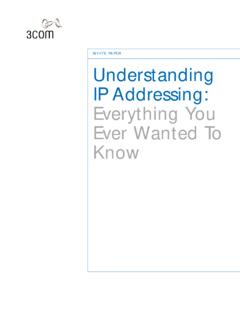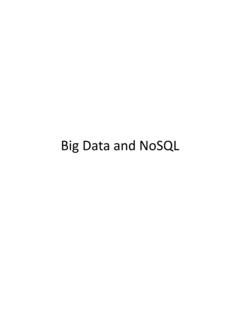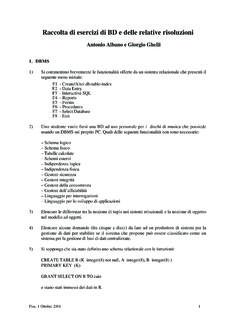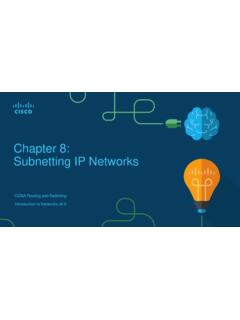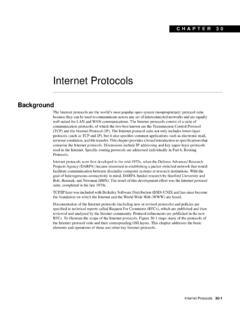Transcription of Understanding IP Addressing
1 WHITE PAPERU nderstandingIP Addressing :Everything YouEver Wanted ToKnowUnderstanding IP Addressing : EverythingYou Ever Wanted To KnowCONTENTSI nternet Scaling Problems 1 Classful IP Addressing 3 subnetting 7 Variable Length subnet Masks (VLSM) 18 Classless Inter-Domain Routing (CIDR) 31 New Solutions for Scaling the Internet Address Space 39 IPv6 Resolves IPv4 Issues 42 Additional IPv6 Features 49 Keeping Current on Internet Addressing Issues 50 Appendix A - References 52 Appendix B - Classful IP Addressing 55 Appendix C - subnetting Exercises 57 Appendix D - VLSM Exercise 61 Appendix E - CIDR Exercises 66 IIIU nderstanding IP Addressing :Everything You Ever Wanted To KnowThe Internet continues to grow at a phenomenal rate. This is reflected inthe tremendous popularity of the World Wide Web (WWW), the opportu-nities that businesses see in reaching customers from virtual storefronts,and the emergence of new ways of doing business.
2 It is clear that expandingbusiness and public awareness will continue to increase demand for accessto resources on the Internet. Internet Scaling ProblemsOver the past few years, the Internet has experienced two major scalingissues as it has struggled to provide continuous and uninterruptedgrowth: The eventual exhaustion of IP version 4 (IPv4) address space The need to route traffic between the ever increasing number of net-works that comprise the Internet The first problem is concerned with the eventual depletion of the IPaddress space. IPv4 defines a 32-bit address which means that there areonly 232 (4,294,967,296) IPv4 addresses available. As the Internet con-tinues to grow, this finite number of IP addresses will eventually beexhausted. The address shortage problem is aggravated by the fact that portions ofthe IP address space have not been efficiently allocated.
3 Also, the tradi-tional model of classful Addressing does not allow the address space tobe used to its maximum potential. The Address Lifetime Expectancy(ALE) Working Group of the Internet Engineering Task Force (IETF) hasexpressed concerns that if the current address allocation policies are notmodified, the Internet will experience a near to medium term exhaus-tion of its unallocated address pool. If the Internet s address supplyproblem is not solved, new users may be unable to connect to the globalInternet. More than half of all possible IPv4 addresses have beenassigned to ISPs, corporations, and government agencies, but only anestimated 69 million addresses are actually in 1. Network Number GrowthThe second problem is caused by the rapid growth in the size of theInternet routing tables. Internet backbone routers are required to main-tain complete routing information for the Internet.
4 Over recent years,routing tables have experienced exponential growth as increasing num-bers of organizations connect to the Internet. In December 1990 therewere 2,190 routes, in December 1995 there were more than 30,000routes, and in December 2000 more than 100,000 routes. Unfortunately, the routing problem cannot be solved by simplyinstalling more router memory and increasing the size of the routingtables. Other factors related to the capacity problem include the grow-ing demand for CPU horsepower to compute routing table/topologychanges, the increasingly dynamic nature of WWW connections andtheir effect on router forwarding caches, and the sheer volume of infor-mation that needs to be managed by people and machines. If the num-ber of entries in the global routing table is allowed to increase withoutbounds, core routers will be forced to drop routes and portions of theInternet will become unreachable.
5 The long-term solution to these problems can be found in the wide-spread deployment of IP Next Generation (IPng or IPv6). Currently,IPv6 is being tested and implemented on the 6 Bone network, which isan informal collaborative project covering North America, Europe, andJapan. 6 Bone supports the routing of IPv6 packets, since that functionhas not yet been integrated into many production routers. Until IPv6can be deployed worldwide, IPv4 patches will need to be used andmodified to continue to provide the universal connectivity users havecome to IP ADDRESSING2 FIGURE 2. Growth of Internet Routing TablesClassful IP AddressingWhen IP was first standardized in September 1981, the specificationrequired that each system attached to an IP-based Internet be assigneda unique, 32-bit Internet address value. Systems that have interfaces tomore than one network require a unique IP address for each networkinterface.
6 The first part of an Internet address identifies the network onwhich the host resides, while the second part identifies the particularhost on the given network. This creates the two-level Addressing hierar-chy that is illustrated in Figure 3. In recent years, the network number field has been referred to as thenetwork prefix because the leading portion of each IP address identifiesthe network number. All hosts on a given network share the same net-work prefix but must have a unique host number. Similarly, any twohosts on different networks must have different network prefixes butmay have the same host number. Primary Address ClassesTo provide the flexibility required to support networks of varying sizes,the Internet designers decided that the IP address space should bedivided into three address classes-Class A, Class B, and Class C. This isoften referred to as classful Addressing .
7 Each class fixes the boundarybetween the network prefix and the host number at a different pointwithin the 32-bit address. The formats of the fundamental addressclasses are illustrated in Figure 4. 3 FIGURE 3. Two-Level Internet Address StructureFIGURE 4. Principle Classful IP Address FormatsOne of the fundamental features of classful IP Addressing is that eachaddress contains a self-encoding key that identifies the dividing pointbetween the network prefix and the host number. For example, if thefirst two bits of an IP address are 1-0, the dividing point falls betweenthe 15th and 16th bits. This simplified the routing system during theearly years of the Internet because the original routing protocols did notsupply a deciphering key or mask with each route to identify the lengthof the network prefix. Class A Networks (/8 Prefixes)Each Class A network address has an 8-bit network prefix, with thehighest order bit set to 0 (zero) and a 7-bit network number, followedby a 24-bit host number.
8 Today, Class A networks are referred to as /8s (pronounced slash eight or just eights ) since they have an 8-bit network prefix. A maximum of 126 (27 -2) /8 networks can be defined. The calculationsubtracts two because the /8 network is reserved for use as thedefault route and the /8 network (also written 127/8 ) is reserved for the loopback function. Each /8 supports amaximum of 224 -2(16,777,214) hosts per network. The host calculation subtracts twobecause the all-0s (all zeros or this network ) and all-1s (all ones or broadcast ) host numbers may not be assigned to individual hosts. Since the /8 address block contains 231 (2,147,483,648 ) individualaddresses and the IPv4 address space contains a maximum of 232(4,294,967,296) addresses, the /8 address space is 50 percent of the totalIPv4 unicast address space. Class B Networks (/16 Prefixes)Each Class B network address has a 16-bit network prefix, with the twohighest order bits set to 1-0 and a 14-bit network number, followed by a16-bit host number.
9 Class B networks are now referred to as /16s sincethey have a 16-bit network prefix. A maximum of 16,384 (214 ) /16 networks can be defined with up to65,534 (216-2) hosts per network. Since the entire /16 address blockcontains 230 (1,073,741,824) addresses, it represents 25 percent of thetotal IPv4 unicast address space. Class C Networks (/24 Prefixes)Each Class C network address has a 24-bit network prefix, with thethree highest order bits set to 1-1-0 and a 21-bit network number, fol-lowed by an 8-bit host number. Class C networks are now referred to as /24s since they have a 24-bit network prefix. A maximum of 2,097,152 (221 ) /24 networks can be defined with up to254 (28-2) hosts per network. Since the entire /24 address block con-tains 229 (536,870,912) addresses, it represents percent (or one-eighth) of the total IPv4 unicast address space.
10 Understanding IP ADDRESSING4 Other ClassesIn addition to the three most popular classes, there are two additionalclasses. Class D addresses have their leading four bits set to 1-1-1-0 andare used to support IP Multicasting. Class E addresses have their leadingfour bits set to 1-1-1-1 and are reserved for experimental use. Dotted-Decimal NotationTo make Internet addresses easier for people to read and write, IPaddresses are often expressed as four decimal numbers, each separatedby a dot. This format is called dotted-decimal notation. Dotted-decimal notation divides the 32-bit Internet address into four 8-bit fields and specifies the value of each field independently as a deci-mal number with the fields separated by dots. Figure 5 shows how atypical /16 (Class B) Internet address can be expressed in dotted-decimalnotation. Table 1 displays the range of dotted-decimal values that can be assignedto each of the three principle address classes.
